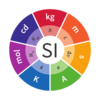Physics (Basic) Flashcards
What’s the
problem-solving acronym?
- *G**eorge iven
- *W**ashington ant
- *K**arver now
- *P** lan
- *E** xecute
- *A**nuts ssess

Definition:
A
_____
is what each
physical quantity is
measured against.
standard
Definition:
A
standard
is what each
physical quantity is
_____.
measured against
Definition:
A
_____ is a
unique name we assign to
measures of a
physical quantity.
unit

Definition:
A
unit is a
unique name we assign to
measures of a
_____.
physical quantity

Definition:
_____
are a small number of
physical quantities whose
units are used to
define the terms of the
derived units.
Base units

Definition:
Base units
are a small number of
physical quantities whose
units are used to
_____ of the
derived units.
define the terms

Definition:
Base units
are a small number of
physical quantities whose
units are used to
define the terms of the
_____.
derived units

Name one
derived unit.
watt
“kilogram-meter squared
per
second cubed”

“giga-“
indicates 10 raised to
what power?

“mega-“
indicates 10 raised to
what power?

“kilo-“
indicates 10 raised to
what power?

“milli-“
indicates 10 raised to
what power?

“micro-“
indicates 10 raised to
what power?

Definition:
A
_____ is a
ratio of units that is
equal to
one.
conversion ratio
1 min = 1 = 60 s
60 s 1 min
Definition:
A
conversion ratio is a
ratio of units that is
equal to
_____.
one
1 min = 1 = 60 s
60 s 1 min
Definition:
_____ use
several conversion factors.
Chain-link conversions
Definition:
_____ is
mass
over
volume.
Density

Definition:
Density is
_____
over
volume.
mass

Definition:
Density is
mass
over
_____.
volume

Model:
If
_____ of an object move in the
same direction at the same rate,
its motion can be modeled as a
single, point-like particle.
all parts
Model:
If
all parts of an object move in the
_____ at the _____,
its motion can be modeled as a
single, point-like particle.
same direction
same rate
Model:
If
all parts of an object move in the
same direction at the same rate,
its motion can be modeled as a
_____.
single, point-like particle
To describe
position, you need
- _____ (direction)
- origin (zero point)
- distance (unit)
axis


















